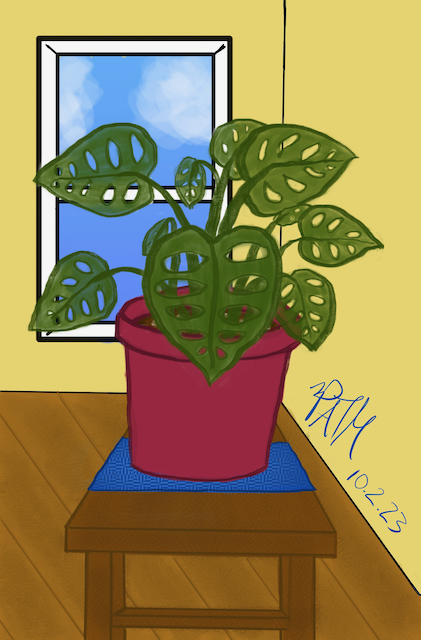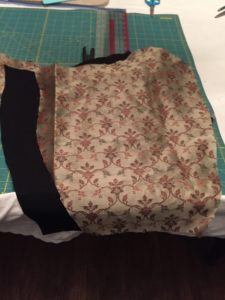I mentioned in my post about Celebration de Medici that I was surprised I hadn’t written about making that outfit… it turns out I did! I just never posted it. So here’s the post, originally written in 2020 about a project from 2018. Wibbly wobbly timey wimey stuff, I know. I’ve added commentary from 2024 in italics.
Introduction
Yet another project from 2018! This is the last one, finally.
The Academie Atlantienne de la Danse (of which I am Chatelaine) held a dance competition at the Kingdom Arts & Sciences Festival in February 2018. My canton decided to enter two versions of the dance Leoncello. (You can watch our performance here. Ragna and I also danced an encore which you can see here.)
[I stepped down from the position of Chatelaine for the Academie when I stepped up as Minister of Arts & Sciences for my local group.]
I had been doing a lot of work on the evolution of 15th century Italian dance and wanted to showcase that. We picked Leoncello because it was the first dance I had traced like that as well as the fact that we had performed it a couple of years prior so we already had good familiarity with it. Leoncello was also one of the most popular dances of the 15th century. We can document it being danced for nearly a hundred years. We danced the original version by Domenico in 1455 and then the latest recorded version from 1517.
We decided as part of our performance to also include the clothing. We wanted to have group members to represent the evolution of clothing that happened over the course of the evolution of the dance. Several of the group members already had appropriate clothing for the end of the era, around 1500 to 1520. No one had outfits appropriate for when the dance was originally written around 1455. (Although the manuscript it is from was written in 1455 we believe Domenico created the dance some years prior to that.) So Ragna and I ended up dancing together and determining to be the couple in the earlier clothing, which meant that we needed to make pellandi. (Houppelande is the French term for this garment that was popular all over Europe in the 15th century. Italy seems to have abandoned it a lot sooner than Northern Europe as well.)

I decided to cross-dress and make a male outfit for the competition because, well, look at those guys: don’t you want to feel that fabulous too?
Inspiration images from Sienese frescoes – https://www.wga.hu/html_m/d/domenico/bartolo/pellegri/ – scroll down to “Feeding of the Poor (detail)” and look at the gentleman in blue.
The Layers
I cheated rather a lot on the bottom layer. I wore modern leggings because I didn’t have time to make hose. The men’s version of the camisa also generally had a different neckline than the women’s, but I already had this one so I wore it. The boots are the same modern ones that look vaguely appropriate that I wear with a lot of my garb.
The second layer is the farsetto or doublet. I forgot to take any in-progress photos. The fabric is just a linen I got from fabric-store. In order to pattern this we started from one of my gamurra bodice and sleeve patterns. (There were multiple guilds of tailors for different thins in Venice in the 15th century, however, the same tailors for mens doublets made womens gowns. Seemed a reasonable starting point.) We drafted the skirting panels based on a few images. For the sleeves I added width to the top half of my existing sleeve pattern and then gathered that into the regular bottom half. I am not certain how it would actually have fastened in this timeframe but hooks and eyes existed and seem logical. [I actually never got the hooks and eyes sewn on and it was pinned in place on the day of.]



The final layer is the pellando. I had the green/gold brocade in my stash. I think I was originally planning to make a giornea out of it, but I’m not sure it would have been enough fabric. I patterned this based on Cynthia Virtue’s houppelande patterning ideas. Some of the pellandi in the images from this timeframe appear to use a different construction method, with a yoke at the shoulders and then pleats below. The pleats were probably set in place with a tape behind them. If I ever make another I would like to try this method.
Ragna and I developed the sleeve pattern based on the images and some basic measurements of my arm, along with a lot of guess work. We were very pleased after we had already cut and started work on the sleeves to find other people’s patterns for this style of sleeve that matched ours, as well as images that showed the seam placement in the same place as what we had done. I did a lot of hand-finishing work on the sleeves. They are the only part of this that is fully-lined as we did not have enough of the brown velvet to line the whole garment.
Reflections

I liked how this turned out. We looked good together and everything really came together how I wanted it to with the pellando. Also, do you know how much stuff you can fit in those sleeves? I walked around with a water bottle in one sleeve and a sandwich in the other for a large chunk of the day. (Not a little sandwich, a hoagie.) I don’t know how much difference it really made to my dancing, although I felt bouncier than when wearing long skirts.
I wish I had had time to make a fabulous hat like the gentlemen in the frescoes. The hat I used worked but isn’t nearly as amazing. I think that’s my main regret about the outfit. [I substituted a green flat cap this time and it worked better than the other one I had in 2018 but I still want a fabulous hat for this outfit.]
2024 Reflections
I LOVED wearing this outfit again to teach dance at Celebration de Medici. The sleeves are fun, it still has full skirts for maximum swoosh but also you can see my legs as I explain how to do complicated steps! I may have mildly sprained my ankle jumping around like a fool because it really does inspire that kind of behavior.
I’m planning to make some mild modifications to the farsetto and make an actual appropriate under-shirt this year. I would also like to make a masculine giornea for warmer weather. That pellando is WARM. Overall, I think there’s a lot more masculine 15th century garb in my future.



































































